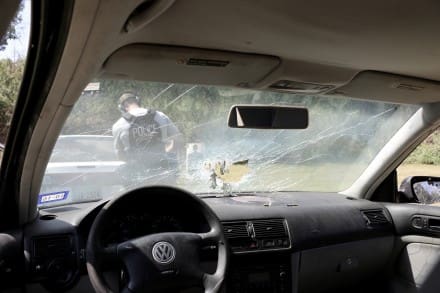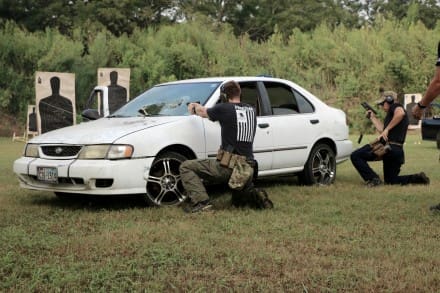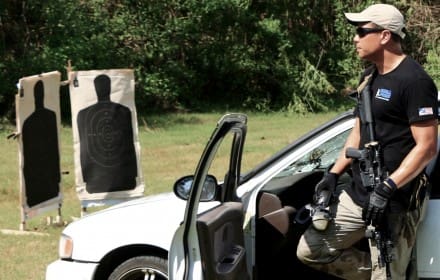A “combat snapshot” refers to how much information a shooter can process in his environment. This is both a proactive and retroactive process. For example, if an individual proceeds into a room from a hallway, he identifies the layout of the new room while remembering the layout of the hallway. This mental process is what helped our ancestors avoid becoming dinner for lions, and is what helps us perform other tasks such as texting while driving.
Our minds default to pattern recognition. If we enter an unfamiliar room (whether in combat or at a dinner party), our eyes will be drawn to motion. Our brains then employ a friend or foe heuristic that indicates whether we can remain calm or if other action should be taken (e.g. get out, there’s a lion at this dinner party!).
The quality at which we perceive information determines whether we receive data that is actionable or just noise. Entering a crowded room, you can scan the environment by simply moving your eyes within their sockets. Moving your head left and right may be necessary to gather data at different angles, but if we jerk our heads too quickly, any information about our surroundings becomes a blur. Another gift passed on to us from our ancestors is our body’s preference for expending the least amount of effort possible to accomplish a task. Unnecessary movement expends precious energy, but can also signal to predators our location.
Excessive movement also distracts our ability to obtain a combat snapshot. Recall any time you’ve been in the woods hunting or just hiking with family. Regardless of being a soldier or civilian, if you hear something that doesn’t sound right, you naturally slow your movement and alter your posture to scan your surroundings. Your eyes scan in their sockets, and your head moves in a methodical manner to assess the environment.
Consider that natural behavior in the woods and apply it to range training. Although tactical shooters are taught a variety of techniques for gaining a combat snapshot or regaining situational awareness, some methods tend place greater emphasis on performing pre and post shooting rituals. Unfortunately these movements provide no advantage in the real world, or worse, actually contradict our natural survival instincts.
Search and assess theatrics are heavily critiqued among instructors with extensive combat or use of force experience. Although it is important to maintain situational awareness, unnecessary head whipping movements do little to provide a shooter with actionable data. The sister action to theatrical search and asses is a movement I’m going to coin as “spider monkeying”. This occurs when barriers or vehicles are incorporated in flat range training. Rather than reading the terrain and modifying their posture, shooters begin to bob and weave their head around obstacles. This is accompanied by excessive pushing and pulling of a pistol in and out of ready positions (e.g. position three to position four, back to position three, etc).
At full speed, spider monkeying looks like a shooter continuously bobbing and weaving like a boxer, combined with the push-pulling of a pistol into and away from his chest. This behavior occurs for two reasons. First, the shooter is attempting to maximize perceived cover while mistakenly assuming that the extra bob and weave movements are causing the enemy to remain reactive. Second, the shooter knows where all of the targets are located and isn’t required to alter his approach. Instead he can just shoot the scenario similar to a USPSA stage with no regards to application of cover and minimizing his silhouette.
Spider monkeying emphasizes the importance of adding blind shoots to range training. When a shooter must interact with a tactical scenario similar to the real world, it decelerates his movements. Instead of exaggerated bobbing, a shooter obtains a combat snapshot through purposeful action and throttle control. Although a shooter might transition between moving quickly and slowly, these are still deliberate actions as opposed to random head jerking. Why? Because in an uncertain environment, excessive movement will either visually give away your position or inhibit your ability to read data in the environment.
Further examination of throttle control can be observed in certain war movies and combat helmet camera footage. This week marked the 23rd anniversary of the events that would become famous through “Black Hawk Down”. Despite the movie’s delineation from actual events, the actors did do justice through their tactical portrayal of Rangers and Delta Operators. Weapon’s handling and fire team movements appeared similar to the real world. No unnecessary head bobbing or peek-a-boo, just methodical clearing of sectors.
Throttle control is also observed by watching helmet camera footage of soldiers in Iraq and Afghanistan. When soldiers make contact with the enemy there is chaos and ambiguity as platoons attempt to identify where the enemy is located. What is not readily observable is unnecessary movement. During the initial phases of a firefight, it is very hard to tell where enemy fire is coming from unless you are amid the enemy’s formation. This is why soldiers minimize their silhouette and scan their sectors to find new data to add to their combat snapshot. Unnecessary movement is not only disorienting, but it might attract the attention of a PKM machine gunner.
Our instincts represent the culmination of handed down survival mindset from our ancestors. Every lion evaded, spear dodged, or musket ball avoided has fined tuned our senses. To our advantage, we are genetically hardwired to avoid threats. In preparing for violent encounters, we should utilize as much of these senses as possible during range training events.
Aaron Barruga is a Special Forces veteran and founder at Guerrilla Approach LLC. He teaches vehicle tactics and speed shooting for tactical marksmanship.
www.guerrillaapproach.com
www.facebook.com/guerrillaapproach
www.instagram.com/guerrilla_approach
Gunfighter Moment is a weekly feature brought to you by Bravo Company USA. Bravo Company is home of the Gunfighters, and each week they bring us a different trainer to offer some words of wisdom.





Well written article Aaron.
IMHO texting while driving is dangerous.
I think he meant it as a contemporary example of task stacking/prioritization and how the task(wrong as it may be) is theoretically accomplished. And the volume at which it is executed without incident is still unbelievably high despite legislation prohibiting it and common sense. The fact remains it IS a complex skill in itself (even though most that do don’t know how to drive to begin with).
Tell that to any pilot who is required to fly the plane, act as tour bus host, navigate, and communicate, all at the same time. Flying has to be at the top of professions requiring a multi-task oriented mindset and training. Compared to that, texting while driving is a piece of cake, especially with voice to text capabilities.
Very insightful and thanks.
Being in a vehicle with a potential or real threat is what usually crosses me up. Given the barriers it’s hard to judge how much movement is necessary as you either try to gain cover or plot an egress.
But that’s just my nightmare.
Not just yours. Being in that situation led me to buying a firearm the next day after it occurred.
Thank you for posting a gunfighter moment that is somthing more than a popular tv host telling us to use whatever he is currently sponsored by.
Agreed!
So the youtube vids of cory jackson scanning left to right after a string of shots, and then spinning in a 360 are not gonna be of any purpose?
Nailed it once again Aaron. Must add to my range day on Monday. Thanks again!
The is the epitome of simple, fundamental and essential information. Well done.
Aaron:
I appreciate the thoughtfulness you put into the articles you write and the classes you teach. Throttle Control: your incorporation of a simple Kim’s Game into shooting drills, as we did during the most recent Speed Shooting for CQB Marksmanship class really drove the point home for me. Mike